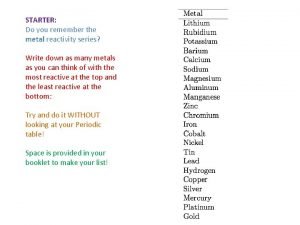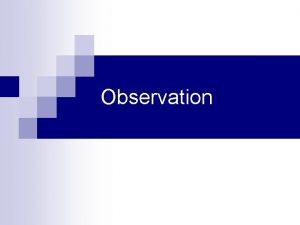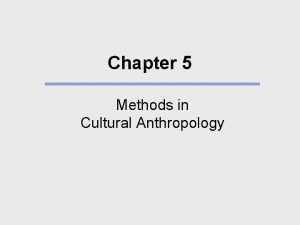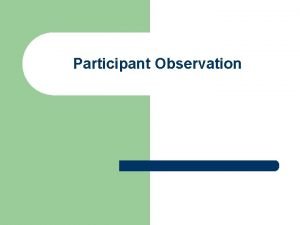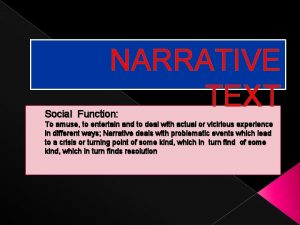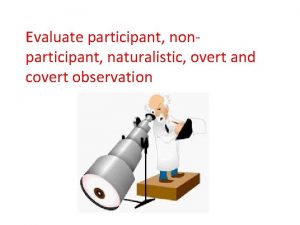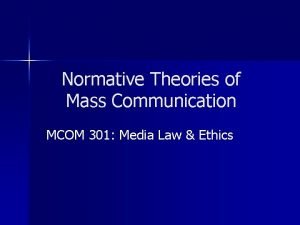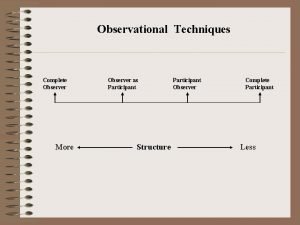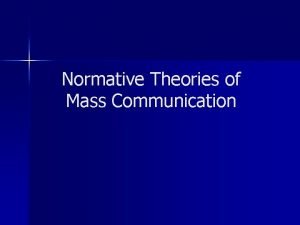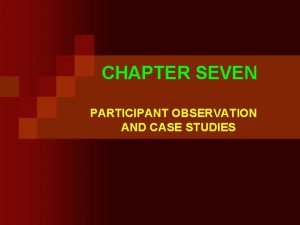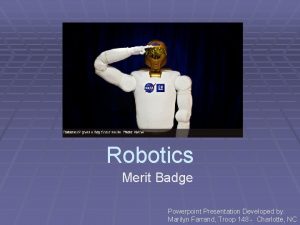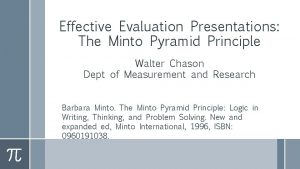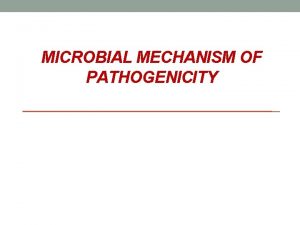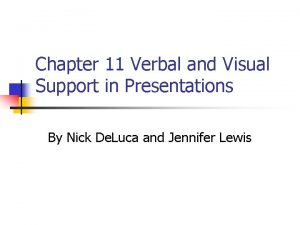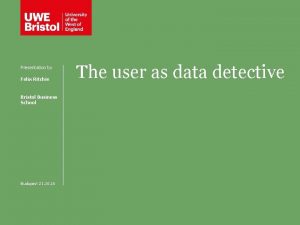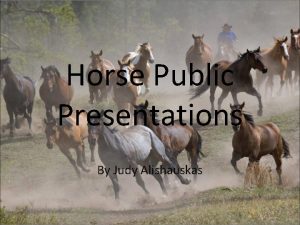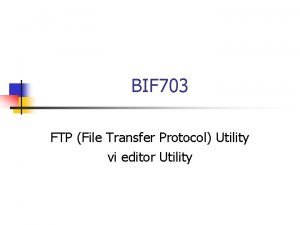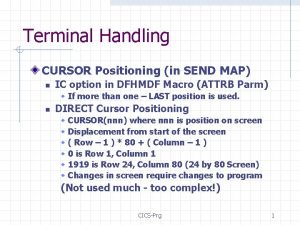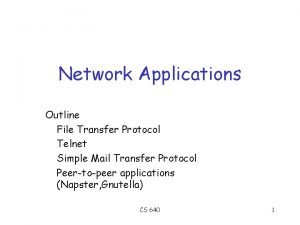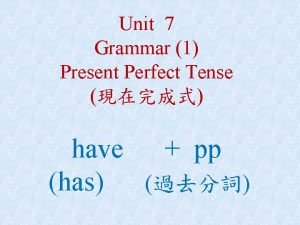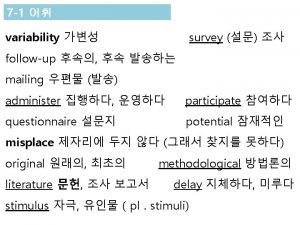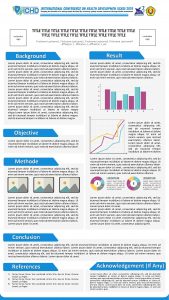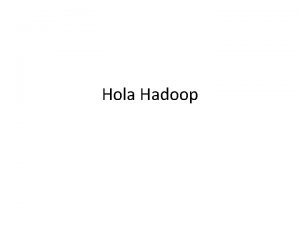Participant Presentations Please Send Title o o o

























































































- Slides: 89

Participant Presentations Please Send Title: o o o Seoyoon Cho Sumit Kar Jose Sanchez Yue Pan David Bang Dhruv Patel Wei Gu Bohan Li Siqi Xiang Nicolas Wolczynski Mingyi Wang

Kernel Embedding •

Kernel Embedding Toy Example 4: Radial Basis Embedding + FLD Is Excellent! Checkerboard

Kernel PCA •

Kernel PCA 1 st Component Finds Coarse Scale Green vs. Blues

Kernel PCA 2 nd Component Separates Blue & Cyan Strong Locality!

Kernel PCA 3 rd Component Splits Greens

Kernel PCA •

t-SNE Visualization Main Idea: Induces Kernel PCA Type Locality Data Gaussian Kernel Transformation Kernel Space Pushes Away Farther Points Cauchy Kernel Transformation MDS Type Representers Optimization: Make Close As Possible

t-SNE Visualization •

t-SNE Visualization Perplexity = 30 (Default) Keeps Local Structure But Global Rearangement And Outlier Cluster is Split

Support Vector Machines Motivation: • Find a linear method that “works well” for embedded data • Note: • Suggests value of Embedded data are very non-Gaussian really new approach

Support Vector Machines Graphical View, using Toy Example:

Support Vector Machines Graphical View, using Toy Example: • Find separating plane • To maximize distances from data to plane • In particular smallest distance • Data points closest are called support vectors • Gap between is called margin Caution: For some “margin” is different

SVMs, Optimization Viewpoint •

SVMs, Computation •

SVMs, Comput’n & Embedding •

SVMs, Comput’n & Embedding •

SVMs, Comput’n & Embedding Implicit vs. Explicit Embedding: Still defined only via inner products • Retains optimization advantage • Thus used very commonly • Comparison to explicit embedding? • Which is “better”? ? ? Explored in Schölkopf & Smola (2002) Via Mercer’s Theorem

SVMs, Tuning Parameter •

SVMs, Tuning Parameter •

SVMs, Tuning Parameter • For Large Values of C Lots of Data Piling Large Angle to Optimal Thus Less Generalizable (For This Data Set) Called Hard Margin SVM

SVMs, Tuning Parameter •

SVMs, Tuning Parameter • For Small Values of C No Apparent Data Piling Smaller Angle to Optimal So More Generalizable Connection to MD? Add MD Axis to Plot

SVMs, Tuning Parameter • Note: For C Small SVM Dir’n = = MD Dir’n

SVMs, Tuning Parameter • For Large Values of C SVM not MD Hard Margin SVM Clearly Different Yet Same for Small C! (For This Data Set)

SVMs, Tuning Parameter •

Support Vector Machines Important Extension: Multi-Class SVMs Hsu & Lin (2002) Lee, Lin, & Wahba (2002) • Defined for “implicit” version • “Direction Based” variation? ? ?

Support Vector Machines SVM Tuning Parameter Selection: Joachims (2000) Wahba et al. (1999, 2003)

Distance Weighted Discrim’n •

Distance Weighted Discrim’n Toy e. g. : Maximal Data Piling Direction MDP - Perfect Separation - Gross Overfitting Feels Small Scale - Large Angle Noise Artifacts - Poor Gen’ability

Distance Weighted Discrim’n Toy e. g. : Support Vector Machine Direction - Bigger Gap - Smaller Angle - Better Gen’ability Similarly Feels Small Scale Noise Artifacts - Feels support vectors too strongly? ? ? - Ugly subpops? - Improvement?

Distance Weighted Discrim’n Toy e. g. : Distance Weighted Discrimination - Addresses these issues - Smaller Angle - Better Gen’ability - Nice subpops - Replaces min dist. by avg. dist.

Distance Weighted Discrim’n Based on Optimization Problem: For “Residuals”:

Distance Weighted Discrim’n Based on Optimization Problem: Uses “poles” to push plane away from data

Distance Weighted Discrim’n Based on Optimization Problem: More precisely: Work in appropriate penalty for violations Optimization Method: Second Order Cone Programming • “Still convex” gen’n of quad’c program’g • Allows fast greedy solution • Can use available fast software (SDP 3, Michael Todd, et al)

Distance Weighted Discrim’n References for more on DWD: • Main paper: Marron, Todd and Ahn (2007) • Links to more papers: Ahn (2006) • R Implementation of DWD: CRAN (2014) • SDPT 3 Software: Toh et al (1999) • Sparse DWD: Wang & Zou (2016)

Distance Weighted Discrim’n References for more on DWD: • Faster Version: Lam et • Approach: three-block semiproximal alternating direction method of multipliers Will Discuss al. (2018) More Later Robust (Against Heterogeneity) Version: Wang & Zou (2016)

Distance Weighted Discrim’n 2 -d Visualization: Pushes Plane Away From Data All Points Have Some Influence (not just support vectors)

Distance Weighted Discrim’n •

Support Vector Machines Graphical View, using Toy Example:

Support Vector Machines Graphical View, using Toy Example:

Distance Weighted Discrim’n Graphical View, using Toy Example:

HDLSS Discrim’n Simulations Main idea: Comparison of • SVM (Support Vector Machine) • DWD (Distance Weighted Discrimination) • MD (Mean Difference, a. k. a. Centroid) Linear versions, across dimensions

HDLSS Discrim’n Simulations •

HDLSS Discrim’n Simulations •

HDLSS Discrim’n Simulations Spherical Gaussians:

HDLSS Discrim’n Simulations •

HDLSS Discrim’n Simulations Outlier Mixture:

HDLSS Discrim’n Simulations •

HDLSS Discrim’n Simulations Wobble Mixture:

HDLSS Discrim’n Simulations •

HDLSS Discrim’n Simulations Nested Spheres:

HDLSS Discrim’n Simulations Nested Spheres: 1 st d/2 dim’s, Gaussian with var 1 or C 2 nd d/2 dim’s, the squares of the 1 st dim’s (as for 2 nd degree polynomial embedding) • Each method best somewhere • MD best in highest d (data non-Gaussian) • Methods not comparable (realistic) • Methods converge for higher dimension? ? • HDLSS space is a strange place Ignore RLR (a mistake)

HDLSS Discrim’n Simulations Conclusions: • Everything (sensible) is best sometimes • DWD often very near best • MD weak beyond Gaussian Every Dog Has his Day Caution about simulations (and examples): • Very easy to cherry pick best ones • Good practice in Machine Learning – “Ignore method proposed, but read paper for useful comparison of others”

HDLSS Discrim’n Simulations Caution: There additional players E. g. Regularized Logistic Regression looks also very competitive Interesting Phenomenon: All methods come together in very high dimensions? ? ?

HDLSS Discrim’n Simulations Can we say more about: All methods come together in very high dimensions? ? ? Mathematical Statistical Question: Mathematics behind this? ? ?

Batch and Source Adjustment Important Application of Distance Weighted Discrimination

Batch and Source Adjustment • For Stanford Breast Cancer Data From Perou et al (2000) • Microarray for Measuring Gene Expression • Old Style: Arrays Printed in Lab

Batch and Source Adjustment • For Stanford Breast Cancer Data From Perou et al (2000) • Analysis in Benito et al (2004) • Adjust for Source Effects – Different sources of m. RNA • Adjust for Batch Effects – Arrays fabricated at different times

Idea Behind Adjustment • • • Early Approach: Alter et al (2000) Squash Out PC 1 direction Eliminates variation in that direction

DWD: Why not PC 1? - PC 1 Direction feels variation, not classes - Also eliminates (important? ) within class variation

DWD: Why not PC 1? - Direction driven by classes - “Sliding” maintains (important? ) within class variation

E. g. even worse for PCA - PC 1 direction is worst possible

But easy for DWD Since DWD uses class label information

Batch and Source Adjustment •

Source Batch Adj: Raw Breast Cancer data

Source Batch Adj: Source Colors

Source Batch Adj: Batch Colors

Source Batch Adj: Biological Class Colors

Source Batch Adj: Biological Class Col. & Symbols

Source Batch Adj: Biological Class Symbols

Source Batch Adj: Source Colors

Source Batch Adj: PC 1 -3 & DWD direction

Source Batch Adj: DWD Source Adjustment

Source Batch Adj: Source Adj’d, PCA view

Source Batch Adj: Source Adj’d, Class Colored

Source Batch Adj: Source Adj’d, Batch Colored

Source Batch Adj: Source Adj’d, 5 PCs

Source Batch Adj: S. Adj’d, Batch 1, 2 vs. 3 DWD

Source Batch Adj: S. & B 1, 2 vs. 3 Adjusted

Source Batch Adj: S. & B 1, 2 vs. 3 Adj’d, 5 PCs

Source Batch Adj: S. & B Adj’d, B 1 vs. 2 DWD

Source Batch Adj: S. & B Adj’d, B 1 vs. 2 Adj’d

Source Batch Adj: S. & B Adj’d, 5 PC view

Source Batch Adj: S. & B Adj’d, 4 PC view

Source Batch Adj: S. & B Adj’d, Class Colors

Source Batch Adj: S. & B Adj’d, Adj’d PCA

Participant Presentation Bryce Rowland: NMF for Hi-C Data Thomas Keefe: Haar Wavelet Bases Feng Cheng: Magnetic Resonance Fingerprinting
 Reactivity series of metals
Reactivity series of metals Will you please be quiet please raymond carver
Will you please be quiet please raymond carver Title fly of a report
Title fly of a report Title title
Title title Participant oriented evaluation
Participant oriented evaluation Non participant observation
Non participant observation Safe at home participant
Safe at home participant Participant tracking software
Participant tracking software Participant-driven research
Participant-driven research Eacea participant portal
Eacea participant portal Narrative ethnography
Narrative ethnography Transferring lifting repositioning
Transferring lifting repositioning Overt observation limitations
Overt observation limitations Participant tracking software
Participant tracking software Contoh social function of the text
Contoh social function of the text Complaint against depository participant
Complaint against depository participant Participant diary/log
Participant diary/log Covert and overt observation
Covert and overt observation Uwindsor participant pool
Uwindsor participant pool Samhsa anger management
Samhsa anger management Participant sample
Participant sample Democratic participant media theory
Democratic participant media theory Complete observer
Complete observer Types of normative theory
Types of normative theory Dalumat salita
Dalumat salita Carmen heijligers
Carmen heijligers Participant media
Participant media Participatory observation
Participatory observation Eacea participant portal
Eacea participant portal Contoh total participation
Contoh total participation Job description and job specification in hrm
Job description and job specification in hrm Dsf.ca/participant
Dsf.ca/participant Participant expectations
Participant expectations Theories of the press
Theories of the press Tlr participant worksheet answers
Tlr participant worksheet answers Participant portal h2020
Participant portal h2020 Tok presentations
Tok presentations Ria seminar system
Ria seminar system Introduction to mental health awareness presentation
Introduction to mental health awareness presentation Types of oral presentations
Types of oral presentations Catchy titles for presentations
Catchy titles for presentations Aironet 3500 presentations
Aironet 3500 presentations The most dangerous game ppt
The most dangerous game ppt Areas donde se utilizan las presentaciones electronicas
Areas donde se utilizan las presentaciones electronicas Roof ppt presentations
Roof ppt presentations Efficient elements powerpoint
Efficient elements powerpoint Boardworks flash
Boardworks flash The best and worst powerpoint presentations
The best and worst powerpoint presentations Merit badge powerpoint presentations
Merit badge powerpoint presentations Bad powerpoint presentations examples
Bad powerpoint presentations examples Note cards for presentations
Note cards for presentations Best and worst powerpoint presentations
Best and worst powerpoint presentations Developing oral and online presentations
Developing oral and online presentations Https creativemarket.com templates presentations
Https creativemarket.com templates presentations Youexec powerpoint template
Youexec powerpoint template Scqa analysis
Scqa analysis Advantages of multimedia presentation
Advantages of multimedia presentation Really bad powerpoint
Really bad powerpoint The end pictures for presentations
The end pictures for presentations Verbal support meaning
Verbal support meaning Business presentations bristol
Business presentations bristol Craft of scientific presentations
Craft of scientific presentations Horse topics for presentations
Horse topics for presentations Customer service presentations
Customer service presentations Catchy titles for science projects
Catchy titles for science projects Internet presentations
Internet presentations Slidetodoc.com
Slidetodoc.com You exec slides
You exec slides Useful phrases presentation
Useful phrases presentation Difference between internet and www
Difference between internet and www Don't hit send
Don't hit send Send recv mpi
Send recv mpi Send email using java
Send email using java Bif file transfer
Bif file transfer Send governor questions
Send governor questions How to write an email to your teacher
How to write an email to your teacher Where does oedipus send creon at the beginning of the play
Where does oedipus send creon at the beginning of the play Role of send governor
Role of send governor Eibtrmid
Eibtrmid Hunger games chapter 10 questions and answers
Hunger games chapter 10 questions and answers Uwpydmoifcm -site:youtube.com
Uwpydmoifcm -site:youtube.com Crucible unit test
Crucible unit test File transfer protocol telnet
File transfer protocol telnet Exec cics web open
Exec cics web open Bradford send inspection
Bradford send inspection Children go where i send thee
Children go where i send thee Book of isaiah chapter 6 send me
Book of isaiah chapter 6 send me Professional email to professor
Professional email to professor Present perfect unit 7
Present perfect unit 7 Who will go send me
Who will go send me
